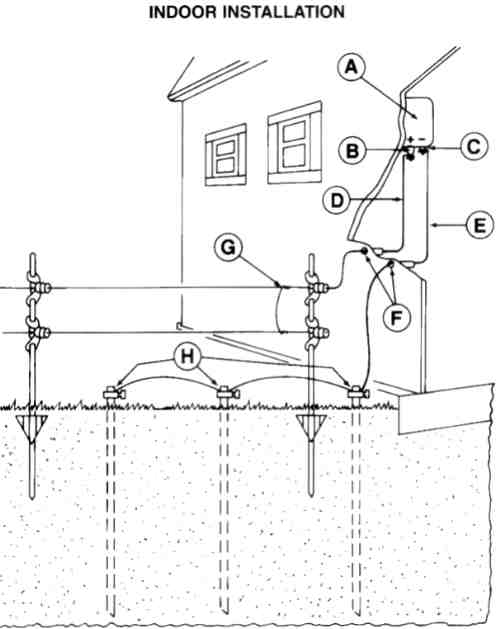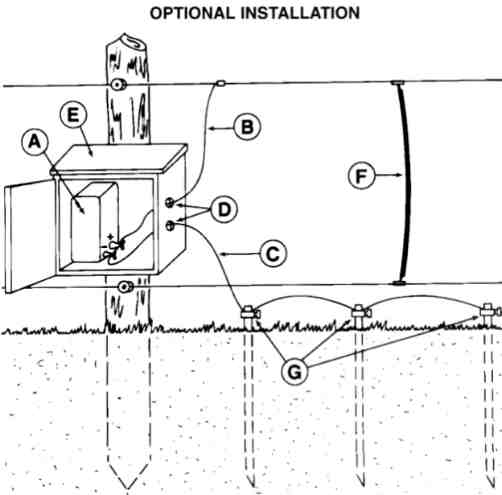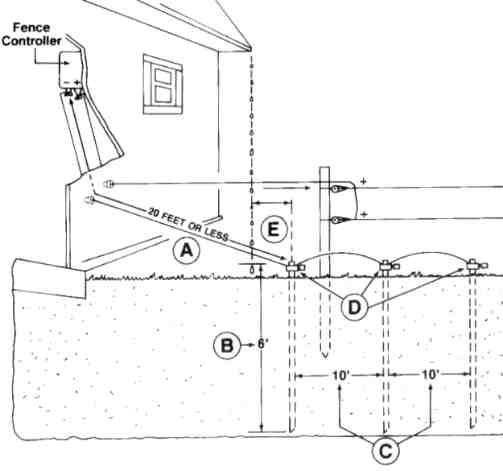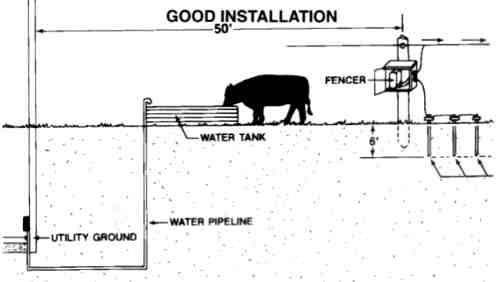HOW TO INSTALL YOUR FENCE CONTROLLER
Grounding Instructions:
The fence controller must be grounded. If it should malfunction or break down, grounding reduces the risk of electrical shock by providing a path of low resistance for the electric current.
AC line operated controllers are provided with a polarized 2-blade attachment plug for use on a 120-volt circuit. The plug must be inserted into an appropriate outlet that is properly installed in accordance with all local codes and ordinances.

A. Fence controller. B.
Fence terminal. C. Ground terminal. D. Insulated ( 20,000V) lead-out wire,
10-14 gauge. E. Insulated ( 600V to 20,000V) ground wire, 10-14 gauge. F.
1/ 2 inch holes for lead-out and ground wire. G. Insulated ( 20,000V)
jumper wire, 10-14 gauge. H. Ground system.
Grounding of this product is provided by a properly installed ground rod electrically connected to the fence controller output ground terminal. An internal fault on an improperly grounded fence controller could result in a risk of high electric shock currents on the electrified fence.
DANGER - For an AC line operated fence controller, do not modify the plug provided with the controller if it will not fit the outlet; have a proper outlet installed by a qualified electrician.
If it is necessary to use an extension cord, use only a polarized extension cord that will accept the plug for the unit. Repair or replace a damaged cord.
STEP
1
Install your fence controller under cover and protect all electrical
connections from moisture. The fence controller lead-out wire carries
voltage from the ( hot) fence terminal to the fence. A jumper wire carries
voltage from one electrified fence line to another ( i. e. , gates, buried
wire, corners, and multiple wire fence systems) . Use insulted cable that
is manufactured for electric fencing ( 10 to 14 gauge wire insulated to
20,000 volts) . Do not use common electrical
wiring; it is only rated for 600 volt use.

A. Fence controller. B.
Insulated ( 20,000V) lead-out wire, 10-14 gauge, from fence terminal. C.
Insulated ( 600V to 20,000V) ground wire, 10-14 gauge, from ground
terminal. D. 1/ 2 inch holes for lead-out and ground wire. E. Protective
cover. F. Insulated ( 20,000V) jumper wire, 10-14 gauge. G. Ground system.
STEP
2
Install at least one 6 ft.
galvanized or copper ground rod within 20 ft. of the fence controller.
Although one ground rod may work, we recommend 3 or more for maximum
performance and shock intensity. Remember ,
additional ground rods increase shock intensity. Use ground rod clamps to
attach insulated ground wire to the ground rod ( clamp must bite into rod
and ground wire) . The wire should be 10 to 14 gauge wire and insulated
from 600 to 20,000 volts. For best results,
install 3 ground rods into the earth 6 ft. deep, spaced 10 ft. apart. If
possible, install ground rods in areas of constant moisture.

A. First ground rod driven
within 20 feet of fence controller. B. Ground rods constructed of copper
or galvanized metal driven 6 feet deep. C. Ground rods spaced 10 feet
apart. D. Use brass grounding clamps. They will not corrode when used with
copper, galvanized or aluminum lead-out wires. E. First ground rod driven
beyond the drip-line of a building's eaves.
STEP
3
Do not install
ground rods within 50 ft. of a utility ground rod, buried telephone line,
or buried water-line ( they may pick up stray voltage) . This is evident
if you receive pulsing shocks from water spigots or water tanks or if you
hear the pulse of the fence controller in your phone, television, or
radio.

POOR INSTALLATION: Note
the flow of electricity to the water tank and the reaction of the cow
being shocked.

PROPER INSTALLATION: Note
the flow of electricity to the ground rods and the cow drinking calmly
from the water tank.
STEP
4
Make good connections, using wire clamps, wire connectors, and proper
splices ( refer to drawings) . Simply wrapping the wire loosely causes
corrosion at the splice and reduces the power on the fence. Use high
quality insulators, gate handles, and insulator wrap, with UV ( ultra
violet) inhibitors for your fence. If using metal fence posts, make sure
fence wires cannot touch the post. There are specific types of wood posts
designed for electric fence use without insulators.